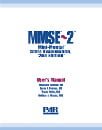
Mini-Mental State Examination, 2nd Edition mmse-2
For: Screen for cognitive impairment
Reading Level: 18 to 100 years
Format: Paper and Pencil
Length: 5 minutes for the MMSE-2:BV; 10-15 minutes for the MMSE-2:SV; 20 minutes for the MMSE-2:EV
Scoring: Hand Scored
Kits
Click to browse products
Paper Forms & Handscoring Materials
Test forms, response booklets and scoring reference manuals.
MMSE-2 Expanded Version Kit
MMSE-2 Standard Version Kit
MMSE-2 Brief Version (BV) Blue Forms (pack of 25)
MMSE-2 Brief Version (BV) Red Forms (pack of 25)
MMSE-2 Standard Version (SV) Blue Forms (pack of 25)
MMSE-2 Standard Version (SV) Red Forms (pack of 25)
Authors
Marshal F. Folstein, MD and Susan E. Folstein, MD; User’s Manual by Marshal F. Folstein, MD, Susan E. Folstein, MD, Travis White, PhD, and Melissa A. Messer, MHS
Description
With a new standard version that is equivalent to the original MMSE and new brief and expanded forms, the MMSE-2 retains clinical utility and efficiency while expanding its usefulness in populations with milder forms of cognitive impairment, including subcortical dementia. The original MMSE is one of the most frequently used brief assessment of cognitive impairment. It can be used to track patients’ progress over time, to screen large populations for cognitive impairment, and to select patients for clinical trials research in dementia treatment. In revising the MMSE, the authors sought a variety of improvements. To better standardize its administration, some of the original MMSE items have been altered. Despite these changes, the MMSE-2: Standard Version (MMSE-2:SV) demonstrates high equivalency with the original MMSE. Thus, it is possible to switch from the original MMSE to the MMSE-2:SV without compromising longitudinal data and without any change in the normal range of scores. An even briefer version, the new MMSE-2: Brief Version (MMSE-2:BV), is designed for rapid assessment in a variety of settings. The MMSE-2: Expanded Version (MMSE-2:EV), a slightly longer version, is more sensitive to subcortical dementia and to changes associated with aging; it is sufficiently difficult that it does not have ceiling effect. Equivalent, alternate forms (Blue and Red) of each MMSE-2 version have been developed to decrease the possibility of practice effects that can occur over serial examinations. Finally, the Pocket Norms Guide has been updated to include norms for all three versions of the MMSE-2 by age and education level and includes reliable change scores to facilitate serial testing with any of the MMSE-2 versions.
Why Should I Use the MMSE-2?
Flexibility of administration. With three different versions available, you can select the version that best fits you and your patients’ needs.
Simplicity of scoring. Forms are user-friendly and easy to score.
Portable Pocket Norms Guide. T-score conversion tables, along with reliable change scores, are provided in both the User’s Manual and the handy Pocket Norms Guide.
Brevity. Depending on the version you choose to use, administration takes between 5 and 20 minutes.
Equivalent, alternate forms. Blue and Red forms enable you to retest the same patient with reduced practice effects.
Simplicity of administration. All versions may be administered by anyone who has been trained to test individuals with cognitive impairment and who is familiar with the administration instructions. No special equipment is required.
Clinical relevance. Items have obvious relationships to functional ability in daily life.
Expanded meta-analysis. The meta-analysis of studies using the MMSE that appeared in the original MMSE Clinical Guide has been expanded to incorporate studies published between 2001 and 2009 and includes effect sizes.
Availability in other languages. Foreign language translations, including Spanish for the US, German, and Italian, will soon be available.
Standardisation and Development
A new normative sample of more than 1,500 individuals was used to establish reliability and the normal range of scores. A clinical sample consisting of patients with Alzheimer’s disease and patients with subcortical dementias was tested to establish validity. To aid you in determining the clinical significance of specific raw scores, the sensitivity, specificity, % correctly classified, positive predictive power (PPP), and negative predictive power (NPP) of a wide range of raw score cutoffs are presented in the User’s Manual for each version of the MMSE-2 by clinical group. In addition, raw score means and standard deviations by age and education level, as well as age- and education-corrected T scores, are provided. Reliable change scores, which provide a measure of the degree of reliable change that has occurred in a patient’s performance between administrations, are provided at three levels of statistical significance.
Reliability and Validity
Internal consistency ranged from .66 to .79 for the clinical sample. Test-retest stability was calculated using generalisability (G) coefficients. Equivalency of the Blue and Red forms was also examined using G coefficients, which were ≥ .96 for all three versions. Interrater reliability was high, ranging from .94 to .99. Convergent validity of the MMSE-2 was examined in terms of its correlations with several tests that purport to measure specific aspects of cognitive functions, including the Wechsler Memory Scale-Third Edition Digit Span Forward and Digit Span Backward subtests, the Category Naming Test, the Boston Naming Test, the Trail Making Test, Judgment of Line Orientation, the Stroop Color and Word Test, the Wechsler Adult Intelligence Scale -Revised Digit Symbol and Block Design subtests, and the Hopkins Verbal Learning Test – Revised.
MMSE-2: Standard Version
The structure and scoring of the original 30-item MMSE have been retained while problematic items have been replaced. The three words for the Registration/Recall tasks have been made slightly more difficult and were revised to make foreign language translations easier. The phrase for the Repetition task has been changed to facilitate its translation into foreign languages, enabling easier comparison of results across all language versions. The Comprehension task has been altered to make it easier for persons with physical limitations to perform. Because the difficulty of the MMSE-2:SV, along with its raw score range, remains the same as the original, scores obtained using the original MMSE and scores obtained using the MMSE-2:SV are comparable.
MMSE-2: Brief Version
Composed entirely of items from the MMSE-2:SV Registration, Orientation to Time, Orientation to Place, and Recall tasks, the 16-item MMSE-2:BV can be used for clinical or research situations that require a rapid cognitive screener. These tasks were chosen based on a literature review, their use in the original MMSE, and their adequate retention of sensitivity and specificity to detect dementia. Available in convenient tear-off pads, the MMSE-2:BV Blue and Red Forms require no stimuli for administration.
MMSE-2: Expanded Version
The MMSE-2:EV improves the clinical utility of the original MMSE by extending the test’s ceiling (i.e., difficulty level), increasing the range of raw scores, and increasing the screening sensitivity for individuals with less severe cognitive impairment, such as those with subcortical dementia and mild cognitive impairment. The 90-item MMSE-2:EV consists of the MMSE-2:SV tasks plus two new tasks: Story Memory (immediate recall of a brief story) and Processing Speed (a symbol-digit coding task). To facilitate scoring of the Processing Speed task, clear plastic Scoring Templates are included in the Expanded Version Kit and are available separately
Also Included:
Equivalent, alternate forms for each of the three versions of the MMSE-2 so as to minimise practice effects when retesting patients.
A representative, up-to-date normative sample to serve as the basis for age- and education-corrected normative T scores.
Evidence of the three MMSE-2 versions’ validity in samples of individuals with Alzheimer’s disease and subcortical dementia.
NB: Prices are in Australian dollars inclusive of GST. NZ customers need to log in to view ex-GST prices.



